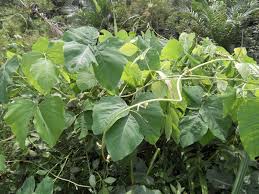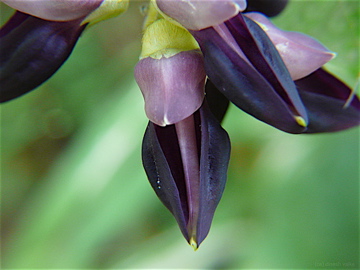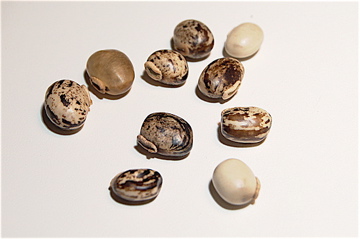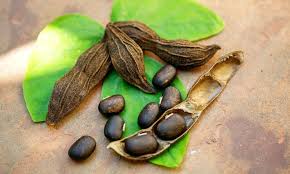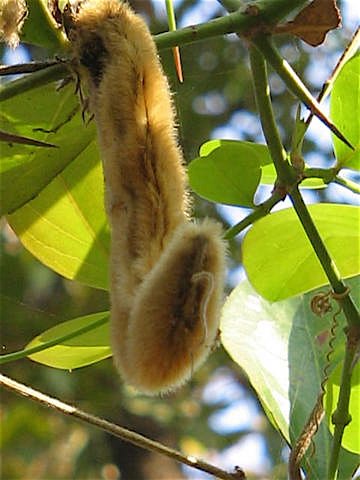Mucuna pruriens
| Botanical Name | Mucuna pruriens |
| Order: | Fabales |
| Family: | Fabaceae ⁄ Leguminosae – Pea family |
| Genus: | Mucuna Adans. – mucuna |
| Species: | Mucuna pruriens (L.) DC. – velvet bean |
| Common Names: | velvet bean, Bengal velvet bean, Florida velvet bean, Mauritius velvet bean, Yokohama velvet bean, cowage, cowitch, lacuna bean, and Lyon bean |
Plant Synonyms
Carpogon capitatus Roxb.
Carpogon niveus Roxb.
Carpopogon capitatus Roxb.
Carpopogon niveum Roxb.
Carpopogon pruriens (L.) Roxb.
Dolichos pruriens L.
Macranthus cochinchinensis Lour.
Marcanthus cochinchinense Lour.
Mucuna aterrima (Piper & Tracy) Holland
Mucuna atrocarpa F.P.Metcalf
Mucuna axillaris Baker
Mucuna bernieriana Baill.
Mucuna capitata Wight & Arn.
Mucuna cochinchinense (Lour.) A.Chev.
Mucuna cochinchinensis (Lour.) A.Chev.
Mucuna deeringiana (Bort) Merr.
Mucuna esquirolii H. Lév.
Mucuna esquirolii H.Lev.
Mucuna hassjoo (Piper & Tracy) Mansf.
Mucuna hirsuta Wight & Arn.
Mucuna luzoniensis Merr.
Mucuna lyonii Merr.
Mucuna martinii H.Lev. & Vaniot
Mucuna minima Haines
Mucuna nivea (Roxb.) DC.
Mucuna nivea (Roxb.) Wight & Arn.
Mucuna prurita (L.) Hook.
Mucuna prurita Wight
Mucuna sericophylla Perkins
Mucuna utilis Wight
Mucuna velutina Hassk.
Negretia mitis Blanco
Stizolobium aterrimum Piper & Tracy
Stizolobium capitatum (Roxb.) Kuntze
Stizolobium cochinchinense (Lour.) Burk
Stizolobium deeringianum Bort
Stizolobium hassjoo Piper & Tracy
Stizolobium hirsutum (Wight & Arn.) Kuntze
Stizolobium niveum (Roxb.) Kuntze
Stizolobium pruriens (L.) Medik.
Stizolobium pruritum (Wight) Piper
Stizolobium utile (Wall. ex Wight) Ditmer
Stizolobium velutinum (Hassk.) Piper & Tracy
Plant Local Names
Inyelekpe (Nigeria) in Igala
Pois mascate (Reunion Island) in French
Agbala (Nigeria) in Ibo
Akpakru (Nigeria) Bekwarra
Devil Beans (Nigeria) in English
Werepe or YerepeYoruba
Iyèkpè in Bini language of (Nigeria)
Nkasi in Nyanja of Zambia and Sepe in Bemba of Zambia
Plant Habitat
The velvet bean is India’s most popular drug, and it is used in over 200 types of drugs. It is native to areas in southern China and Central and South America, as seen in the picture below. Now, it is also widely distributed to other areas of the world such as the West Indies, tropical American, the Pacific Islands, and the United States. Another example of a plant that lives in tropical areas, such as India, is the black pepper.
Mucuna pruriens can grow in very diverse environments. It prefers well-drained soil, but can also grow in sandy soils and soils with great acidity range. Mucuna prefers hot, climates with rainfall ranging between 1,000-2,500 mm, but also can grow in as little as 400 mm of annual rainfall. It does have some tolerance to drought, but Mucuna will not survive in very saturated soils. The best temperature range to grow Mucuna pruriens is between 19-27°C and requires high light intensity to grow.
The velvet beans are climbing vines called lianas that intertwine through the rain forest trees. Their flowers and pods are formed on long, rope like stems that hang from the forest canopy. In less tropical environments, such as the United States, the velvet bean grows alongside other farming crops in fields. It also has the ability to grow on hedges and bushes, as seen in the picture in the bottom right.
Plant Material of Interest
Seed,
Plant Description
The plant is an annual climbing shrub with long vines that can reach over 15 metres (50 ft) in length. When the plant is young, it is almost completely covered with fuzzy hairs, but when older, it is almost completely free of hairs. The leaves are tripinnate, ovate, reverse ovate, rhombus-shaped or widely ovate. The sides of the leaves are often heavily grooved and the tips are pointy. In young M. pruriens plants, both sides of the leaves have hairs. The stems of the leaflets are two to three millimeters long (approximately one tenth of an inch). Additional adjacent leaves are present and are about 5 millimetres (0.2 in) long.
The flower heads take the form of axially arrayed panicles. They are 15–32 centimetres (6–13 in) long and have two or three, or many flowers. The accompanying leaves are about 12.5 millimetres (0.5 in) long, the flower stand axes are from 2.5–5 millimetres (0.1–0.2 in). The bell is 7.5–9 millimetres (0.3–0.4 in) long and silky. The sepals are longer or of the same length as the shuttles. The crown is purplish or white. The flag is 1.5 millimetres (0.06 in) long. The wings are 2.5–3.8 centimetres (1.0–1.5 in) long.
In the fruit-ripening stage, a 4–13 centimetres (2–5 in) long, 1–2 centimetres (0.4–0.8 in) wide, unwinged, leguminous fruit develops. There is a ridge along the length of the fruit. The husk is very hairy and carries up to seven seeds. The seeds are flattened uniform ellipsoids, 1–1.9 centimetres (0.4–0.7 in) long, .8–1.3 centimetres (0.3–0.5 in) wide and 4–6.5 centimetres (2–3 in) thick. The hilum, the base of the funiculus (connection between placenta and plant seeds) is a surrounded by a significant arillus (fleshy seed shell).
M.pruriens bears white, lavender, or purple flowers. Its seed pods are about 10 cm (4 inches) long and are covered in loose, orange hairs that cause a severe itch if they come in contact with skin. The itch is caused by a protein known as mucunain. The seeds are shiny black or brown drift seeds.
The dry weight of the seeds is 55–85 grams (2–3 oz)/100 seeds.
Plant Used Parts
Plant Uses
Plant Therapeutic Action
The main mechanisms of action for a typical Mucuna Pruriens dosage concern what happens to its L-Dopa content once entering the body. L-Dopa is the direct pre-cursor to dopamine, the key neurotransmitter relating to energetic mood, ambition, drive, physical pleasure, and euphoria.
Dopamine itself is not able to cross the blood brain barrier, so even though we recognize its importance for emotional health and energy, it cannot be directly supplemented. Plants which contain dopamine pre-cursors, such as Mucuna, make it possible to increase levels of dopamine in the brain.
Mucuna simultaneously stimulates the other catecholamine hormones epinephrine and norepinephrine. These hormones increase metabolism and fire faster communication to and from nerve cells. Taking a Mucuna dosage also raises the output of serotonin in the brain.
This neurochemical is responsible for mood, sleep and certain facets of memory. As a mood enhancer, it makes an excellent partner to dopamine. Mucuna is also widely used for its effects upon sexual health.
The seed extract has been observed to increase testosterone production in men, and heighten physical sexual sensitivity in women.
Plant Precaution for Use
Plant Adverse Effect
As stated above, Mucuna Pruriens dosages above 1 gram per day are unnecessary and can lead to side effects. These include sweating, heart palpitations, high blood pressure, and nausea.
The intended effects of Mucuna – stress relief, help concentrating thoughts, and a refined experience of physical pleasure, could be negated when the dosage is too high. Therefore there is no reason to increase dosage above 1 gram.
To intensify effects safely and naturally, a better option is to add Mucuna to complementary supplements which also favorably impact mood. One common combination is to add Mucuna to L-Theanine, a glutamic acid which has strong anti-anxiety properties.
Thought of as a natural Xanax, this compound also improves serotonin and dopamine production in users. It harmonizes well with moderate doses of Mucuna, and also mixes well with caffeine. However, if the effects become too intense, you should lower doses, or take the supplements independently of one another.
In any case, improved mood and energized sexual performance will be easily attainable, with the support of these natural supplements for emotional health.
Plant Contraindication
It is possible that very high dosages of mucuna pruriens herb could lead to side effects such as increased body temperature, restlessness, increased heart rate or heart rhythm disturbances, and insomnia.
I have read your information and have a question about the product before ordering. Does it have hallucinations as a side affect? My husband has Parkinson’s disease and he cannot take any of the prescribed meds for it because he has hallucinations. Just wondering if this would create the same problem in him.
We have not had any reports of hallucinations regarding the use of this product.
Plant Dosage Forms
How much Mucuna Pruriens powder should be consumed a day for the best results? With a proven track record stretching back many hundreds of years, it appears that the human body is able to tolerate Mucuna very well. Still it is best to stick to the lower end of the recommended Mucuna Pruriens dosage range.
The median dose which most people take is 500 mg per day. Anyone who is new to Mucuna should try a smaller dose, closer to 100 mg, up to 3 times per day. The maximum dose should not exceed 1 gram per day total.
Above this amount, the supplement will be too stimulating for most people, and users may experience some side effects as listed below.
Plant Dosage
Supplement-wise, 5g of Mucuna Prurients dried powder has been used with efficacy in some human studies on Parkinson's Disease and Fertility. This dose or doses upwards of it should be a good starting point.
If your supplement is standardized for L-DOPA and you are supplementing for an effect attributed to L-DOPA, then start with about 1/2 the L-DOPA equivalent and work up if needed (this is due to the same amount of L-DOPA in Mucuna being more bioactive relative to isolated L-DOPA without carbidopa).
Mucuna Pruriens can be eaten isolated as a food product, but cooking is required to destroy trypsin inhibitors in the beans (so protein absorption is not hindered) yet cooking also destroys L-DOPA.
Some supplements use the cotyledon of Mucuna Pruriens, which may have different nutrient profiles relative to the bean or whole root.
Plant Storage
stored in a cool environment.
Plant Chromatographic Fingerprint
Plant Constituents
Mucuna pruriens contains 40mg/g of a compound called L-DOPA which is a direct precursor to the neurotransmitter dopamine. Dopamine works as one of the best natural hgh releasers (human growth hormone) by stimulating the pituitary gland to increase it's production. High levels throughout life of the body's own natural growth hormone (not hormones from the synthetic injections) is known as a major key for human longevity.
Dopamine also increases other youth hormones such as testosterone (it must be mentioned that these increases are never throwing the endocrine system out of balance, merely improving levels which tend to decrease over time in the average person). These resulting increased levels of these hormones from the use of mucuna pruriens extracts, powders and/or raw herbs explains its association with increasing libido, fertility, lean muscle mass, reducing signs of aging such as wrinkles and body fat, increasing bone density and even boosting overall energy levels.
Animal studies have shown powerful results such as a ten fold increase in mounting frequency by male rats! Also a decrease in post ejaculatory intervals have been observed, meaning that the animals being studied are more quickly able to return to "the task at hand". This could be due to the fact that mucuna pruriens extract basically cures premature ejaculation and the amount of downtown between ejaculations by reducing hypersensitivity in the genitals.
L-DOPA from mucuna pruriens has been shown to be safer and more effective for controlling Parkinson's disease than the pharmaceutical drugs Levodopa and Carbidopa. This is because the vast array of other chemical constituents that accompany L-DOPA in the unprocessed plant also play a role in its ability to manage Parkinson's disease. Since Parkinson's is in large part a deficiency of the neurotransmitter dopamine, this adaptogenic herb is crucial for anyone looking to manage this disease. It also looks to be very promising as a treatment for recovering drug addicts and people suffering from depression related illness, since these people have deficiencies of the neurotransmitters serotonin and dopamine (which the velvet beans contain and help balance in the human body).
Plant Pictures
Plant References
https://nootriment.com/mucuna-pruriens-dosage/,
https://examine.com/supplements/mucuna-pruriens/
Katzenschlager R, et al. Mucuna pruriens in Parkinson's disease: a double blind clinical and pharmacological study. J Neurol Neurosurg Psychiatry. (2004)
